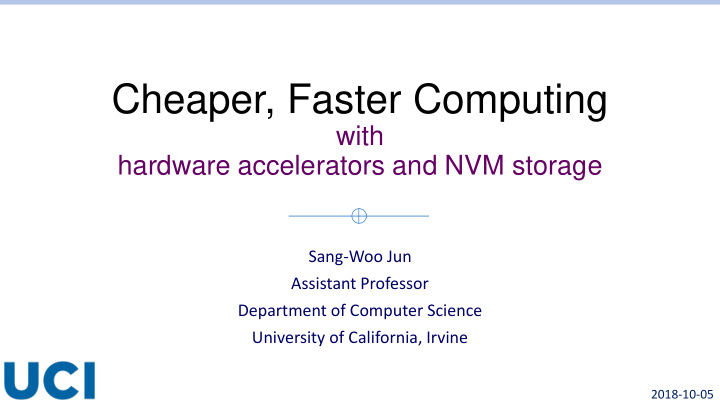



Cheaper, Faster Computing with hardware accelerators and NVM storage Sang-Woo Jun Assistant Professor Department of Computer Science University of California, Irvine 2018-10-05
About Me Sang-Woo Jun Ph.D. (2018) @ MIT Research Interests o Systems architecture o Accelerators o NVM storage o Applications! • Graphs, Bioinformatics, Machine learning… Some Nice Papers o (ISCA, VLDB, FAST, FPGA, …) Some Nice Media Coverage o Engadget, The Next Platform, …
Exciting Time to Be a Compute Architect Google TPU Microsoft Azure Samsung Reconfigurable Processor
A Computer – Some History CPU Program Memory Data Same program runs faster on more data tomorrow Not the most exciting time to be an architect… John Hennessy and David Patterson, “Computer Architecture: A Quantitative Approach”, 2018 (Cropped) Bon-jae Koo, “Understanding of semiconductor memory architecture”, 2007 (Cropped)
Running Into the Power Wall 0.007 μ
Crisis Averted With Manycores? CPU CPU Program Memory Data Bernd Hoefflinger, “ITRS 2028—International Roadmap of Semiconductors”, 2015
Memory/Storage Worries Too! “[…] per gigabit (Gb) has declined from $11 in 2006 to less than $1 [in 2013]” We are still around $0.5 - $1/Gb as of 2018 Processing requirements are still increasing exponentially! Western Digital, “CPU Bandwidth – The Worrisome 2020 Trend”, 2016
The Exascale Challenge Department of Energy requests an exaflop machine by 2020 MIT Research nuclear reactor 1,000,000,000,000,000,000 floating point operations per second 6 MW Using 2016 technology, 200 MW Lynn Freeny, Department of Energy
Smaller Challenges Near Us Smartphones IoT Devices AI Assistants
No Better Time to Be an Architect! “There are Turing Awards waiting to be picked up if people would just work on these things.” —David Patterson, 2018 Photo: Peg Skorpinski,UC Berkeley
A Big Data Application: Personalized Genome Normal Genome Tumor Genome Cancer Patient Next-Generation Sequencing Identified Mutations “Comprehensive characterization of complex structural variations in cancer by directly comparing genome sequence reads,” Moncunill V. & Gonzalez S., et al., 2014
Cluster System for Personalized Genome Complex Algorithm 16 Machines (2 TB DRAM) Terabytes of Data 6 Hours $100,000 7,000 Watts
A Cheaper Alternative Using Hardware-Accelerated SSD + + $2,000 80 Watts
Reconfigurable Hardware Acceleration Field Programmable Gate Array (FPGA) FPGA Program application-specific hardware GPU High performance, Low power Reconfigurable to fit the application Bracco Filippo, “Rationale behind FPGA”, 2017
Storage for Analytics Fine-grained, TB of DRAM DRAM Irregular access Terabytes in size $$$ $8000/TB, 200W Our goal: $ $500/TB, 10W
Research Topics Galore General Specific Accelerator Libraries OS Support Climate Simulation Bioinformatics System Design Programming Systems Machine Learning
Project: Accelerated Object Storage FPGA Acceleration Client Object Virtual Object PCIe/Ethernet Object Object Virtual Object Object • Storage exposes high-level object store abstraction to software • Computation offloaded to accelerator using “virtual objects”, not breaking object store abstraction
Project: Accelerating Stencil Computation for Climate Simulation
Project: Distributed FPGA Cluster
Project: Applications For Accelerator Platform Platform for efficient fine-grained acceleration Goal: 10x performance against baseline Claim: Easy to develop! Candidate applications: Dynamic Time Warping, Smith-Waterman, Cosine Similarity, N-body simulation, … Ideas?
Things To Come! Thank you!
Recommend
More recommend